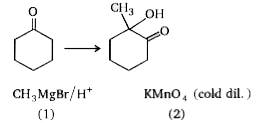In Hoffmann degradation of amide the correct order of reagent is :
Br2,KOH,H2O
KOH,Br2,H2O
H2o,KOH,Br2
None of these
The correct Answer is:B
To solve the question regarding the correct order of reagents in the Hofmann degradation of amides, we will break down the process step by step.
1. Understanding the Reaction:
The Hofmann degradation of amides involves the conversion of an amide into a primary amine with the release of carbon dioxide (CO2). The reaction requires specific reagents to proceed through several steps.
2. First Reagent - Base (KOH):
The first reagent used in the Hofmann degradation is a strong base, typically potassium hydroxide (KOH). The base abstracts an acidic hydrogen from the amide, forming an anion. This step is crucial as it activates the amide for further reactions.
Hint: Remember that a strong base is necessary to initiate the reaction by deprotonating the amide.
3. Second Reagent - Bromine (Br2):
After the formation of the anion, the next step involves the addition of bromine (Br2). The anion attacks the bromine, leading to the formation of an intermediate compound where a bromine atom is now attached to the nitrogen.
Hint: The bromination step is essential for the subsequent rearrangement and migration of groups.
4. Final Step - Water (H2O):
The last reagent added is water (H2O). This step involves the hydrolysis of the intermediate formed in the previous steps, ultimately leading to the formation of a primary amine and the release of CO2.
Hint: Water is crucial for the final protonation and completion of the reaction.
5. Order of Reagents:
Based on the steps outlined, the correct order of reagents in the Hofmann degradation of amides is:
- First: KOH (base)
- Second: Br2 (bromine)
- Third: H2O (water)
Conclusion:
Therefore, the correct order of reagents in the Hofmann degradation of amide is KOH, Br2, and H2O.
Final Answer:
The correct option is KOH → Br2 → H2O.
The Hofmann degradation of amides involves the conversion of an amide into a primary amine with the release of carbon dioxide (CO2). The reaction requires specific reagents to proceed through several steps.
The first reagent used in the Hofmann degradation is a strong base, typically potassium hydroxide (KOH). The base abstracts an acidic hydrogen from the amide, forming an anion. This step is crucial as it activates the amide for further reactions.
After the formation of the anion, the next step involves the addition of bromine (Br2). The anion attacks the bromine, leading to the formation of an intermediate compound where a bromine atom is now attached to the nitrogen.
The last reagent added is water (H2O). This step involves the hydrolysis of the intermediate formed in the previous steps, ultimately leading to the formation of a primary amine and the release of CO2.
Based on the steps outlined, the correct order of reagents in the Hofmann degradation of amides is:
- First: KOH (base)
- Second: Br2 (bromine)
- Third: H2O (water)
Therefore, the correct order of reagents in the Hofmann degradation of amide is KOH, Br2, and H2O.
The correct option is KOH → Br2 → H2O.
Topper's Solved these Questions
- AMINESBOOK - VMC MODULES ENGLISHCHAPTER - AMINESEXERCISE - ENABLE
45 Videos
- AMINESBOOK - VMC MODULES ENGLISHCHAPTER - AMINESEXERCISE - EFFICIENT
49 Videos
- ALDEHYDES,KETONES & CARBOXYLIC ACIDS BOOK - VMC MODULES ENGLISHCHAPTER - ALDEHYDES,KETONES & CARBOXYLIC ACIDS EXERCISE - IN-CHAPTER EXERCISE-M
10 Videos
- ATOMIC STRUCTUREBOOK - VMC MODULES ENGLISHCHAPTER - ATOMIC STRUCTUREEXERCISE - JEE Advanced (Archive )
67 Videos
Similar Questions
Knowledge Check

For the above conversion the correct order of reagents used is :A1→2→3→4B1→4→3rar2C1→4→2→3D2→3→4→1
Correct order is :
View SolutionCorrect order is :
View SolutionThe correct orders are:
View SolutionThe correct order of Cl-O bond order is :
View SolutionAssertion : Hofmann degradation of benzamide gives aniline .
Reason : Hofmann bromamide degradation reaction can be used for descending amine series .
View SolutionThe correct order of increasing order of size is
View SolutionA: In Hofmann's bromamide degradation amines formed containing one carbon atom less than carbon atoms present in amide.
R: This reaction occurs through the formation of nitrine intermediate
View Solution
